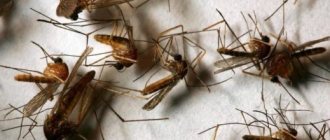Mosquitoes are one of the most common insects on Earth. They are found in every corner of the planet, except Antarctica, and in the warm season it is not difficult to meet them. During the period of their activity, they can greatly annoy a person, biting him and irritating him with their squeaks. If a mosquito manages to fly into an apartment, the owner can expect several minutes of unpleasant hunting. This may raise an interesting question: which floor can a mosquito reach? It might make sense to buy a penthouse in a skyscraper to prevent this pest from getting there.
Aerodynamics features
Scientists from all over the world have been studying the life activity of mosquitoes. Japanese scientists managed to study the aerodynamics of flight. The filming was carried out in slow motion. They filmed in infrared radiation with a camera at a speed of 10 thousand frames per second. The results were published in journals in Japan and Great Britain.
Interesting!
During the research, it became known that during flight the wingspan is only 40 degrees. This is 2 times less than that of bees. With such physiological abilities, a small creature is not able to rise to a high level above the ground. However, the question of where mosquitoes cannot reach remains open.
Factors that increase flight altitude
The size of the insect is about 3 mm in length, the weight of the mosquito is about 2 mg. With such dimensions, the trajectory of movement can easily be changed by the wind. The flight altitude of a mosquito directly depends on weather conditions.
- In the absence of wind, pests rise no more than 15 m above the ground, which is approximately equal to the third floor of a multi-story building.
- According to numerous reviews, they can easily rise to the height of a 9-story building. They were even found at 28. Movement over 15 m is facilitated by the wind, which picks up insects and lifts them upward. The number of pests decreases with each meter, but with a large number of bloodsuckers and on the fifth floor, you will need mosquito nets on the windows to protect your home from annoying bloodsuckers.
- Pests often live in damp basements of multi-story buildings, from there they calmly move up the ventilation shafts and through the elevator. At what height the insect will appear depends on the structure of the high-rise building. There is not much difference if there are shafts and an elevator.
Interesting!
Under the article, which contained information that the mosquito does not rise above the third floor, the maximum height is 15 m, numerous comments poured in. Eyewitnesses claimed that bloodsuckers haunted the 15th floor too. When asked where mosquitoes come from, they claim that they get into the room not through the ventilation grilles or entrance, but from the side of the balcony, where they were often found on the glass from the outside.
How abilities are multiplied
According to official information, the flight height of a mosquito in the wild is limited to 5 meters. Males feed on nectar and plant pollen; there is no point in rising above the greenery. Females need blood, for which they look for a potential victim. Insects hunt animals, birds, and, if possible, attack people. There is no point in climbing to a height of more than 5 m.
In urban environments, mosquitoes en masse occupy the lower floors and do not reach the fourth floor on their own. However, you can meet the pest even on the roof of a building. There are several versions of how they get there:
- blown by the wind;
- fly out of the windows of the lower floors, then rise up;
- they live in basements, damp hallways, and climb up ventilation shafts and elevators.
City mosquitoes live and breed in damp basements and mines. The presence of a person is sensed by the smell of sweat, lactic acid, and carbon dioxide. Elementary instinct forces insects to make their way into human habitation and rise to great heights.
On a note!
The mosquito is capable of laying eggs without feeding on blood. Energy reserves are replenished with flower nectar. However, eggs require large amounts of protein to develop. The female gives up half of her health, weakens herself, and reproduces weak offspring. For this reason, forest and swamp mosquitoes are always angrier, more aggressive, and larger.
Mosquito flight altitude - interesting facts
In general, a mosquito that feeds on the nectar of flowering plants is a very mundane creature. Female mosquitoes drink the blood of humans and animals, which they need for reproduction, but mosquitoes do not lie in wait for their victims in the skies either, even those that bite birds (the so-called ornithophilous mosquitoes). The fact that in nature the mosquito is at the base of food chains does not contribute to the love of high flights - it itself, in the imago stage, is completely devoid of predatory habits, but everything is ready to feast on it with pleasure - including dragonflies and small birds.
In this case, you need to take into account the low weight of the mosquito, which easily becomes a toy of the wind and rising air currents. In the evening, intense jets of warm air rush upward from the sun-heated earth, and with them the mosquito sometimes rises tens of meters. If such an aeronaut happens to be near a residential or office high-rise building in the city, he is quite capable of flying into a window on the twenty-fifth floor. In concrete jungles, hot updrafts over asphalt are especially intense.
Another convenient way for insects to penetrate to the upper floors is ventilation and elevator shafts, where upward air movement is also observed. The prevailing humidity there is a plus for mosquitoes. Live, active mosquitoes were found in ventilation shafts on the 54th floor of a skyscraper in New York. They are almost certainly capable of climbing higher, it’s just that no one has recorded these records.
Mosquitoes thrive on the flat roofs of high-rise buildings if the drains there are not well organized. Females lay eggs in accumulations of stagnant water; they go down to residents’ apartments to hunt. True, on the roof there is a problem with the usual plant food, but recently scientists have discovered among synanthropic mosquitoes a tendency towards aphagia - the absence of the need for food at the stage of the adult insect. The entire life task of females comes down to mating, finding a source of fresh blood, laying eggs and dying. Perhaps insects find food on the flowers of indoor plants. Some of the inhabitants of the roofs return to the ground along with rainwater.
How high do mosquitoes fly?
Small creatures cannot fly higher than 15 m above ground level on their own. The body weight of an ordinary mosquito is about 3 g. The slightest wind currents impede movement and force it to change its trajectory. Based on natural instincts and natural needs, pests do not necessarily have to travel long distances upward. They try to stick to the ground, grass, and ponds with standing water.
On a note!
Insects rise to a height of up to 100 m from the surface of the earth. On the top floors of a multi-storey building it is necessary to install mosquito nets. This does not at all indicate the unique flying ability of a small creature, but it does indicate the presence of accompanying factors.
How to choose your floor?
And yet, on what floor is it better to live in a multi-story building? Let's try to figure it out.
First floor
- Pros: In the event of a collapse, fire or any other emergency, it will be easiest to leave the first floor, at least if the windows are not tightly barred.
- Cons: apartments located on the ground floor most often become victims of robbers. They have the highest noise level, dirty air, basement dampness, and mosquitoes in the summer.
Second floor
- Pros: quite safe. Well suited for older people and young families with children.
- Cons: the same as for apartments on the ground floor, perhaps to a lesser extent.
Third floor
- Pros: in old five-story buildings it has always been considered optimal.
- Cons: if the elevator breaks down, the first inconveniences will begin. It is not catastrophic to overcome this distance on your own, but lifting the furniture will be quite difficult.
From the fourth to the sixth floor
- Pros: from an environmental point of view, they are the safest.
- Cons: if the elevator breaks down, you will need to be in good physical shape to get into your own apartment.
Seventh floor
- Pros: standard high-rise buildings are the golden mean. The noise level is low, the air is cleaner, and the fear of heights is not yet felt.
- Cons: it is better not to live higher for people with an unbalanced psyche, as well as those suffering from cardiovascular diseases.
From the eighth to the sixteenth floor
- Pros: the brightest apartments are located on these floors. Even very tall trees turn out to be shorter.
- Cons: if there are smoking pipes nearby, alas, their negative impact on these floors will be most noticeable.
Seventeenth floor and above
- Pros: wonderful panoramic view, clean air. Heat, as you know, rises, so these apartments are also the warmest.
- Cons: during a fire, the greatest danger lurks here. In addition, toxic products also tend to spread from the bottom up.
Top floor
- Pros: In the event of a fire, assistance can be provided from the roof. On the top floor you can install a fireplace or attach part of the attic.
- Cons: very high risk of robbery. If the house is old, the water pressure will be weak and leaks may occur frequently.
Thus, the central part of the house is the most favorable for living. Therefore, if you are wondering which floor is better to live on in a 17-story building, then pay attention to the eighth and ninth floors.
How high do mosquitoes fly in the wild?
The situation is different away from big cities. There, the flight altitude in meters is determined only by the intensity of natural air currents. But during the process of migration in areas with hilly and mountainous terrain, insects are able to cover considerable distances along an inclined plane. It is difficult to say to what height mosquitoes fly within one life cycle, but it is known that on the hills of Kamchatka they massively attack tourists at the border of the snow cover, that is, at an altitude of 2.5-3 thousand meters.
Mosquito astronauts
The absolute record for distance from the Earth's surface was set by ringing mosquitoes that participated in the Russian-Japanese Space Midge program in 2014. Several thousand larvae, immersed in a state of cryptobiosis (artificial dehydration with the replacement of internal fluid with sugar syrup), went to the International Space Station (ISS), orbiting the Earth at an altitude of 408 km. At the station, a Japanese astronaut-researcher revived the larvae by placing them in water. Then part of the biomaterial was returned to Earth. Orbital experiments continued with the rest of the bloodworm mass. The heroic bloodworm even went into outer space. The larvae died, but the parasitic bacteria that lived in their bodies managed to survive, despite the extremely low temperature and the flow of cosmic radiation.
Flying in the rain
The small creature never ceases to amaze with its abilities. Scientists have recently studied the flight of a mosquito during rain and the height of its movement.
A raindrop measures 8 mm and weighs up to 100 mg, which is several times the size of an insect.
- Once on its paws, the drop slightly changes its trajectory, throws it to the side, and twists it.
- If a drop falls on the body, it does not change its trajectory, carries the insect down several meters, and does not allow it to rise.
- If a drop gets on the body of an insect when it is on a solid base, death occurs.
The experiment was carried out in a special container where rain was artificially created. They filmed what was happening with a camera, and then analyzed what was happening. During rain, bloodsuckers can fly, but their movements are not clearly coordinated; raindrops do not allow them to rise high; maximum flight is at a height of 1 m above the ground.
The structure of mosquitoes and flies is different, they also differ in size, but they annoy humans in the same way. The latter are able to rise much higher, the wind helps to rise higher, and the flight of a fly has its own characteristics.
Advantages of apartments on the ground floor
But you can look at the problem from the other side. After all, if you live on the ground floor, then you get from the apartment to the street and back much faster
In ordinary life, this may not be so important. But if a fire suddenly happens in the house, then you will be very glad that you don’t have to trudge up the stairs from the very top floor, carrying the most expensive thing in your arms, but just go outside, and then still have time to return for the second batch of the most expensive, then for the third etc
Moreover, it is quite possible to leave the apartment through the window.
And it’s convenient to buy large-sized items, since delivery to the entrance is usually free, and then you can somehow strain yourself and drag the coveted new piece of wood into the apartment on your own.
Again, if the apartment is on the ground floor, it is more convenient to keep an eye on your car left near the house. If something happens, you can quickly go out into the street and “hang lulya” on young hooligans who tried to break off something necessary from it, for example, a brand name.
Also, residents of the first floors sometimes even have a small “own” plot in the front garden, where they can plant some gladioli and begonias.
And it’s really great if from your apartment, located on the ground floor, you can exit through a separate exit into a fenced mini garden. This way you can put a bench, create flower beds, or put up a swing for a child. A sort of plot of land attached to a city apartment. Such projects of multi-storey buildings are very rare, but they do occur.
If it happens that your water pipe bursts, then you will not “flood your neighbors” and you will not have to make repairs to them if it is proven that the flood is your fault. On the other hand, if the upper neighbors decide to thoroughly flood someone, then you are unlikely to be able to avoid their flows.
And (I almost forgot) children can run on the floor until they are blue in the face. No one will come to make a fuss from the ground floor for not having it. And finally: the walls on the first floors are usually thicker than on the upper floors, so the audibility will be less (although this rule does not apply to panel houses).
Yes! Somehow there are only advantages. It's time to pour tar.
At what altitude were mosquitoes discovered - amazing facts
On a hot day, the walls of the building become very hot, and in the evening they begin to emit warm air currents that rise to the highest floors. Small mosquitoes fly up with them. Insects are found on skyscrapers, the 20th and 30th floors are common.
There is information that the pests flew to a height of 5 thousand km in the Himalayas. There are several versions of how they got there. They got in with people, initially getting into their belongings, travel bags, backpacks. Somehow the larvae were introduced, and then the adults appeared.
Interesting!
Mosquitoes and flies are amazing creatures that have been studied by specialists for many years. The anatomy is well known, but the abilities continue to surprise. The maximum flight of a fly is 20 m above the surface of the earth, but if the insect purposefully follows a person, it can reach up to 4 km above sea level.
For blood-sucking creatures, the habitat is of greater importance - temperature within 20-25 degrees Celsius, high humidity. Accidental entry of pests into the upper floors shortens the life of the insect and prevents them from laying eggs in favorable places. It can fly to the roof and live in the attic if it leaks and water stagnates.
Disadvantages of apartments on the ground floor
The very first drawback is the proximity of the basement. If you are buying an apartment in a new building, then this is not so bad. But in old houses (which are 20-40 years old), the basement really becomes a source of problems. Firstly: it is smell and dampness. You know, in an ordinary average basement there is always something leaking. Either the sewer breaks, or hot water... All this rises through the cracks into the apartment on the first floor (and sometimes on the second or third).
As an example, I can cite this fact. My parents live in a house built according to a German design. There are really good apartments there, BUT! Every time I enter the entrance, I involuntarily hold my breath and try to leave the first floor without breathing. Why? I just don’t want to inhale the stench that comes from the basement and the garbage chute (there will be a separate discussion about that). This smell practically does not reach the third floor, but in apartments on the first floors there is no escape from it. I asked the residents - they were not happy.
The basement and garbage disposal are not only sources of unpleasant odors, but also a neighborhood with restless inhabitants, such as cockroaches, mice, and even rats. In the apartment where I lived after birth, there was more than enough of this goodness. The matter was aggravated by the fact that the apartment was communal and none of the neighbors made any special efforts to combat rodents. They felt almost like masters in the apartment. Just think about the fight between two rats in the built-in closet - one of the most vivid impressions of childhood! I still remember the squealing sound, and the roar was as if it were not rats, but two rhinoceroses engaged in a mortal fight.
And at night it was better not to leave the room. Rats could easily attack in the corridor and bite your leg. Brrr!
Now this probably no longer exists, but still, the first floor is a potential neighborhood with dangerous creatures. Not now, but over time.
There is another unpleasant thing about living on the ground floor. Because of the fear of burglary, people have to decorate their windows with bars. No matter how curly and beautiful they are, they will still be grilles. If there is a fire in the house, and the bars are installed properly, then you won’t be able to just jump out of the window. Not everything is as simple as I wrote a few paragraphs earlier.
And finally - a constantly spit-stained entrance, since crowds of people will constantly walk past your doors. This is noise, because they cannot walk in silence - they must definitely shout for the entire entrance. It's the smell of smoke. These are some guys looking into the windows from the street. Yes, a lot more. And God forbid there will be a bench near the entrance under your window. On warm summer nights you won't be able to sleep - guess why.
Maybe over time I’ll remember something else and add it.
Where to hide?
What is the maximum flight altitude of a mosquito? “To the ceiling” is the traditional humorous answer. Indeed, why should he strive upward if he can calmly have lunch or dinner nearby, if not with blood, then with nectar and pollen. And yet it’s just interesting - how high can this insect fly if it really needs to? Nature instills in them a sense of survival, and you can survive where it is warm and humid, where there are plants, and therefore food, and warm-blooded animals or humans, so that offspring can be raised.
Apartment on the top floor - pros and cons
The highest floor I've ever lived on is the fifteenth. I still live here. I’m sitting here, writing this text and at the same time looking at the sunset outside the window:
Sometimes there are such beautiful sunsets, it’s just a miracle! Sit in front of the window and take pictures!
Even though my floor is not the top, I still have some idea of the problems that my neighbors who live two floors above face.
The first problem is a hot roof in the summer. Even if the house has a technical floor, the roof of the house still warms up during the day so that it becomes impossible to breathe in the apartments on the top floor. The air conditioner, of course, is a good thing, but he, the dog, eats electricity with large spoons. So either fry or pay.
Another problem is that if the pumps are not powerful enough, then interruptions in water supply occur. Especially during peak hours, when all residents begin to take baths at the same time. We don’t have this problem at home, but in the neighboring neighborhood we do. They were less fortunate.
Thin walls - excellent audibility. The fact is that in high-rise buildings the walls on different floors actually have different thicknesses. At the bottom they are thicker, the higher they are, the thinner the walls become. This is done to facilitate the construction of the upper floors, so that you can save on the foundation and building materials in general.
I remember when we just moved into a new apartment, no one lived in the neighboring one for a long time. It was quiet and calm. And then suddenly they started doing renovations there. And then the neighbor himself moved in and started making noise at night. No, he didn’t shout, didn’t turn on the music. He and his wife just sat in their room and talked. And not to say that it was so loud. And we lay behind the wall in our bedroom and could not sleep, because we clearly heard every word. So audibility on the upper floors is the price to pay for the beautiful view from the window. But, living on the very top floor, you will never be disturbed by noise from neighbors above.
Now that the main pros and cons are listed, let me go through the most common myths that are often taken for granted when buying apartments.











